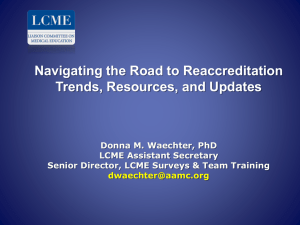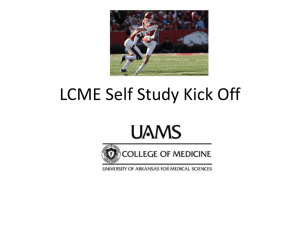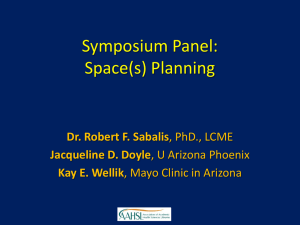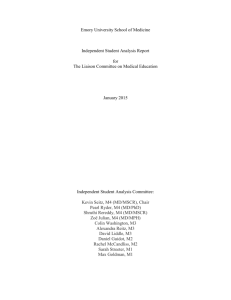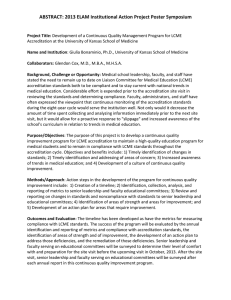Document 13178834
advertisement
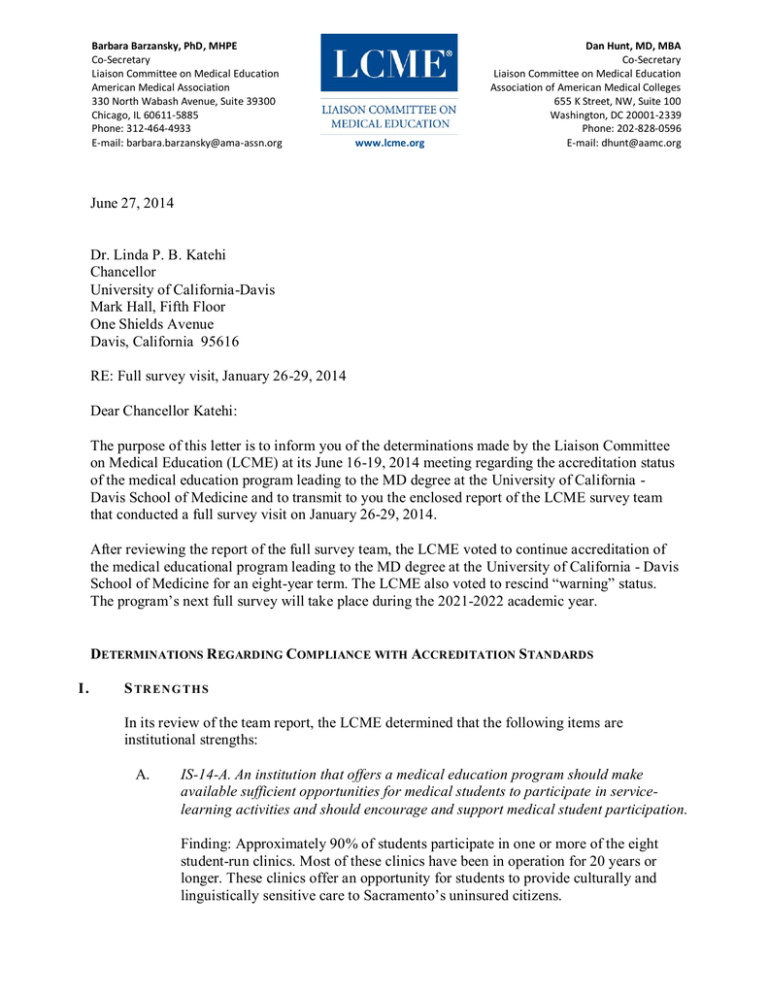
Barbara Barzansky, PhD, MHPE Co-Secretary Liaison Committee on Medical Education American Medical Association 330 North Wabash Avenue, Suite 39300 Chicago, IL 60611-5885 Phone: 312-464-4933 E-mail: barbara.barzansky@ama-assn.org www.lcme.org Dan Hunt, MD, MBA Co-Secretary Liaison Committee on Medical Education Association of American Medical Colleges 655 K Street, NW, Suite 100 Washington, DC 20001-2339 Phone: 202-828-0596 E-mail: dhunt@aamc.org June 27, 2014 Dr. Linda P. B. Katehi Chancellor University of California-Davis Mark Hall, Fifth Floor One Shields Avenue Davis, California 95616 RE: Full survey visit, January 26-29, 2014 Dear Chancellor Katehi: The purpose of this letter is to inform you of the determinations made by the Liaison Committee on Medical Education (LCME) at its June 16-19, 2014 meeting regarding the accreditation status of the medical education program leading to the MD degree at the University of California Davis School of Medicine and to transmit to you the enclosed report of the LCME survey team that conducted a full survey visit on January 26-29, 2014. After reviewing the report of the full survey team, the LCME voted to continue accreditation of the medical educational program leading to the MD degree at the University of California - Davis School of Medicine for an eight-year term. The LCME also voted to rescind “warning” status. The program’s next full survey will take place during the 2021-2022 academic year. DETERMINATIONS R EGARDING COMPLIANCE WITH ACCREDITATION STANDARDS I. S TR E N G T H S In its review of the team report, the LCME determined that the following items are institutional strengths: A. IS-14-A. An institution that offers a medical education program should make available sufficient opportunities for medical students to participate in servicelearning activities and should encourage and support medical student participation. Finding: Approximately 90% of students participate in one or more of the eight student-run clinics. Most of these clinics have been in operation for 20 years or longer. These clinics offer an opportunity for students to provide culturally and linguistically sensitive care to Sacramento’s uninsured citizens. Dr. Linda P. B. Katehi Page 2 B. ED-36. The chief academic officer of a medical education program must have sufficient resources and authority to fulfill his or her responsibility for the management and evaluation of the curriculum. Finding: Course leaders uniformly praise the support they receive from staff members in the Office of Medical Education, including assistance in test development and scoring; logistical coordination for courses; and consultation in instructional development; and advice on the selection, development, and integration of software. This assistance frees up the time of Instructors of Record and faculty to concentrate on the planning and delivery of instruction and to engage in instructional innovation. The school of medicine generously funds the Office of Medical Education to allow it to fulfill its role of faculty support. C. ER-4. A medical education program must have, or be assured the use of, buildings and equipment appropriate to achieve its educational and other goals. Finding: The facilities to support medical education, including the Education Building and the new Center for Health and Technology, are excellent. The latter building includes innovative technologies, including simulation, clinical skills teaching, and telemedicine, that enhance opportunities for student learning and patient care. II. C O M P L I AN C E , WI TH A NEED FOR M O N I TO R I N G NOTE: As the revised accreditation standards and elements, approved by the LCME at its February 2014 meeting, are due to go into effect beginning on July 1, 2015, both the current standard and the related element are listed below. The LCME determined that the medical education program is in compliance with the following accreditation standards, but that ongoing monitoring is required to ensure continued compliance: A. IS-16. An institution that offers a medical education program must have policies and practices to achieve appropriate diversity among its students, faculty, staff, and other members of its academic community, and must engage in ongoing, systematic, and focused efforts to attract and retain students, faculty, staff, and others from demographically diverse backgrounds. Element 3.3. A medical school has effective policies and practices in place, and engages in ongoing, systematic, and focused recruitment and retention activities, to achieve mission-appropriate diversity outcomes among its students, faculty, senior administrative staff, and other relevant members of its academic community. These activities include the use of programs and/or partnerships aimed at achieving diversity among qualified applicants for medical school admission and the evaluation of program and partnership outcomes. Dr. Linda P. B. Katehi Page 3 Finding: While they have diversity policies in place, given their student body and the community in which they reside, their faculty percentages are surprisingly low and below the national averages for both African Americans/Blacks and Hispanics. B. ED-31. Each medical student in a medical education program should be assessed and provided with formal feedback early enough during each required course or clerkship rotation to allow sufficient time for remediation. Element 9.7. A medical school ensures that each medical student is assessed and provided with formal formative feedback early enough during each required course or clerkship four or more weeks in length to allow sufficient time for remediation. Formal feedback typically occurs at least at the midpoint of the course or clerkship. A course or clerkship less than four weeks in length provides alternate means by which a medical student can measure his or her progress in learning. Finding: The 2012-2013 Block 2 immunology, microbiology, and metabolism-endorepro-nutrition courses used USMLE-style items in the final examination. The formative assessment in these courses was not comparable, so that students could not accurately judge their learning and engage in appropriate remediation, resulting in an unexpected and unprecedented number of student failures. C. FA-13. A medical education program should ensure that there are mechanisms in place for direct faculty involvement in decisions related to the program. Element 1.3. A medical school ensures that there are effective mechanisms in place for direct faculty participation in decision-making related to the medical education program, including opportunities for faculty participation in discussions about, and the establishment of, policies and procedures for the program, as appropriate. Finding: The recently approved bylaws related to the membership of the Committee on Educational Policy would change the voting membership to consist only of the Instructors of Record for the required courses and clerkships. This potential limitation to broad-based and direct faculty involvement in educational program decision-making will go into effect in the summer of 2014, if an anticipated change to the process for modifying bylaws does not occur. III. N O N C O M P L I AN C E WI TH S T AN D AR D S NOTE: As the revised accreditation standards and elements, approved by the LCME at its February 2014 meeting, are due to go into effect beginning on July 1, 2015, both the current standard and the related element are listed below. The LCME determined that the medical education program is currently out of compliance with the following accreditation standard: Dr. Linda P. B. Katehi Page 4 A. ED-30. The directors of all courses and clerkship rotations in a medical education program must design and implement a system of fair and timely formative and summative assessment of medical student achievement in each course and clerkship rotation. Element 9.8. A medical school has in place a system of fair and timely summative assessment of medical student achievement in each course and clerkship of the medical education program. Final grades are available within six weeks of the end of a course or clerkship. Finding: In the independent student analysis, concern was expressed about the timeliness of clerkship evaluations. The school has instituted a central monitoring and notification process. The result is that all students have received their grades within six weeks for the past four rotations. REQUIRED FOLLOW-UP In order to address the compliance issues mentioned above, the LCME has requested that the dean submit a status report by August 15, 2015 containing the information listed below. Please refer to http://www.lcme.org/survey-connect-followup-reports.htm for current LCME submission requirements. STATUS REPORT DUE AUGUST 15, 2015 I. COMPLIANCE, WITH A NEED FOR MONITORING A. IS-16 (diversity)/Element 3.3 (diversity/pipeline programs and partnerships) 1. Describe how the institution defines or characterizes diversity for its faculty. 2. Describe how the college has organized and implemented its diversity recruitment efforts for faculty and staff since the time of the 2014 full survey visit. Describe the financial, administrative, and personnel resources that the college has dedicated to the identification, recruitment, and retention of faculty and staff from diverse backgrounds. 3. Describe any faculty development efforts implemented since the time of the 2014 full survey visit to assist faculty search committees to enhance their efforts to identify, recruit, and retain faculty members from diverse backgrounds. Dr. Linda P. B. Katehi Page 5 4. Please complete the following tables: School identified diversity categories Faculty Number and Percent Basic Science Clinical Science 20122013 20132014 20142015 20122013 20132014 Staff (define) Number and Percent 20142015 20122013 20132014 20142015 Offers Made to Applicants for Faculty Positions School identified diversity categories B. 2013 Declined Hired 2013 Total Offers 2014 Declined Hired 2014 Total Offers 2015 (to date) Declined Hired 2015 Total Offers ED-31 (mid-course feedback)/Element 9.7 (formative assessment and feedback) 1. Describe the means by which the occurrence and format of mid-course feedback is monitored within individual departments, courses, and at the curriculum management level for immunology, microbiology, and metabolism-endo-repronutrition courses. 2. Describe the steps taken by the curriculum committee since the 2014 full survey to assure that mid-course formative assessment provides opportunity for students to accurately judge their learning and engage in appropriate remediation. Provide data on the effectiveness of interventions taken (i.e. course passage rates). 3. Provide data available from a survey of students in the first and second years of the curriculum regarding students’ perceptions of the usefulness of formative feedback in the pre-clinical curriculum. Provide the data by class. C. FA-13 (faculty involvement in educational program decisions)/Element 1.3 (mechanisms for faculty participation) 1. Describe the steps taken by the school since the 2014 full survey to assure broadbased and direct faculty involvement in educational program decision-making. Dr. Linda P. B. Katehi Page 6 2. Provide an update on the school’s efforts to modify the process to change the faculty bylaws, so that the membership of the Committee on Educational Policy could be altered to allow for broad-based faculty membership on the committee and involvement in educational program decision-making. 3. Provide a roster of the voting membership of the Committee on Educational Policy. Note whether each member was elected or appointed to the committee (e.g., ex officio, dean’s appointee, faculty election). II. NONCOMPLIANCE WITH STANDARDS A. ED-30 (formative and summative assessment)/Element 9.8 (fair and timely summative assessment) 1. Describe the centralized system that is in place to oversee management and tracking of the return of clerkship grades to students. Describe the institutional policies and procedures that are in place regarding the timely receipt of clerkship grades by medical students. Note what individual or group is responsible for assuring timely return of clerkship grades. Comment on any changes made since the 2014 full survey. 2. For the 2013-14 and 2014-2015 academic years, provide a table showing the average length of time and the range of time for required clerkship grades to be made available to medical students, and the percent of students who do not receive their grades within six weeks in each required clerkship. Comment on any clerkships (or clerkship sites) that are significant outliers. 3. Provide data from a survey of students who were in the third year of the curriculum during the 2014-2015 academic year on satisfaction with the timeliness of grade reporting in clerkships. COMPLIANCE T ERMINOLOGY In reviewing the compliance determinations above, please refer to the attached memorandum for an overview of LCME compliance terminology and note the October 2011 implementation of a new category of compliance called compliance, with a need for monitoring, which indicates that the program is in compliance with the cited accreditation standard, but that monitoring is required to ensure continued compliance. A determination of noncompliance indicates that the program does not meet one or more of the requirements of the cited standard. Dr. Linda P. B. Katehi Page 7 UNITED STATES D EPARTMENT OF EDUCATION R EGULATIONS The LCME is required by United States Department of Education regulations to document compliance with all LCME accreditation standards within two years of a program’s initial notification of noncompliance determinations. Therefore, the LCME will require timely follow-up on all determinations of noncompliance. Please see the “Required Follow-Up” section above for details. NOTIFICATION POLICY The LCME is required to notify the United States Department of Education and the relevant regional accrediting body of all of its final accreditation determinations, including determinations of “Accredited,” “Accredited, with Warning,” and “Accredited, on Probation.” The LCME will also make final determinations of “Accredited” and “Accredited, on Probation” available to the public. Note that the determination “Accredited, on Probation” is only final after a program has exercised its right to waive or undergo an official reconsideration by the LCME. ACCREDITATION STANDARDS To review the current list of LCME accreditation standards and their annotations, please refer to the most recent version of the Functions and Structure of a Medical School document, available on the LCME Web site at http://www.lcme.org/standard.htm. Programs asked to submit status reports are responsible for aligning the follow-up items in the report with the Functions and Structure of a Medical School document that is current at the time the status report is due. CHANGES THAT R EQUIRE NOTIFICATION TO THE LCME Accreditation is awarded to a medical education program based on a judgment that there exists an appropriate balance between student enrollment and the total resources of the institution, including faculty, facilities, and operating budget. If there are plans to significantly modify the educational program, or if there is to be a substantial change in student enrollment or in the resources of the institution such that the balance becomes distorted, the LCME expects to receive prior notice of the proposed change. Substantial changes may lead the LCME to re-evaluate a program’s accreditation status. More specific information about notification requirements is available on the LCME Web site at http://www.lcme.org/change-notification.htm. Dr. Linda P. B. Katehi Page 8 A copy of the survey report is being sent to Dean Julie A. Freischlag, MD. The survey report is for the use of the University of California - Davis School of Medicine and the university, and any public dissemination or distribution of its contents is at the discretion of institutional officials. Sincerely, Barbara Barzansky, PhD, MHPE LCME Co-Secretary Dan Hunt, MD, MBA LCME Co-Secretary Enc (2): New Category of Compliance with LCME Accreditation Standards and Glossary of Compliance Terminology Memorandum Team report of the full survey of the medical education program leading to the MD degree at the University of California - Davis School of Medicine, January 26-29, 2014 CC: Julie A. Freischlag, MD, Dean, University of California, Davis School of Medicine Memorandum SUBJECT: New Category of Compliance with LCME Accreditation Standards and Glossary of Compliance Terminology In its review of survey reports and follow-up status reports, the Liaison Committee on Medical Education (LCME) determines a medical education program’s compliance with individual accreditation standards. Historically, the LCME has used the terms compliance and noncompliance to describe a program’s conformance with accreditation standards. At its June 2011 meeting, the LCME approved a third term called compliance, with a need for monitoring, which falls under the category of compliance with accreditation standards (implemented October 2011).The LCME also adopted formal definitions for the three compliance terms. These three terms are defined below. COMPLIANCE WITH ACCREDITATION STANDARDS Compliance: The required policy, process, resource, or system is in place and, if required by the standard, there is evidence to indicate that it is effective. Compliance, with a Need for Monitoring: 1) The medical education program has the required policy, process, resource, or system in place, but there is insufficient evidence to indicate that it is effective. Therefore, monitoring is required to ensure that the desired outcome has been achieved. OR 2) The medical education program is currently in compliance with the standard, but known circumstances exist that could lead to future noncompliance (formerly “area in transition”). NONCOMPLIANCE WITH ACCREDITATION STANDARDS The medical education program has not met one or more of the requirements of the standard: The required policy, process, resource, or system either is not in place or is in place, but has been found to be ineffective. Updated October 2012
